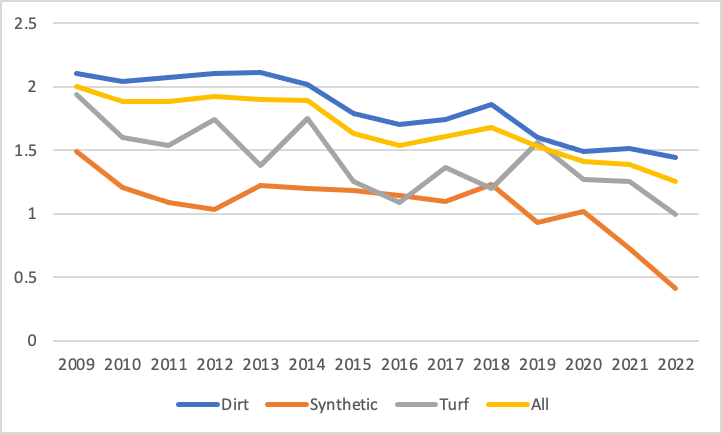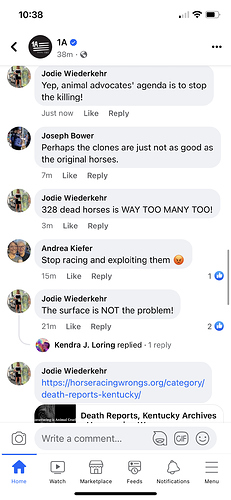Interesting take on what’s happening.
It’s too bad we can’t collect data on the longevity of racehorses who are trained off-grounds (e.g., varied surfaces) to ones that are trained only on the racecourse or similar courses to they race on.
Reminds me of a video from helmet cam that Eventing Nation posted of the Cranbourne gallop track in Melbourne… If this isn’t variation of terrain, I don’t know what is. 
I followed some of the links about the break downs at CD and read about Lost In Limbo’s breakdown. Do not watch the video of it. Ugh, that poor horse. And Kimberley Dream who broke down had a consistent record of losing by a large margin. Something the new rules are trying to address.
From HRN: Kimberley Dream, who had lost her last five races beforehand by 19, 32 1/2, 14 1/2, 31 and 33 lengths, was vanned off the track and later euthanized after veterinarians diagnosed an inoperable leg injury, the statement said.
That is interesting about the varied surfaces. I think similar issues were observed in horses trained using a treadmill. Not enough variance in the surface.
That is just showing fatalities, correct?
Yes (as it says above the list)
I threw the data into a chart:
Very interesting. All declining (good!) but synthetic declining a lot. Maybe a reflection of better synthetics?
I think it’s really cool that the 2022 dirt fatalities per thousand starters is now lower than synthetic fatalities per thousand starters in 2009. We have made a lot of progress in the past 13 years.
Although, 2009 was a bit of an anomalous year because of the rain in SoCal.
I feel like the synthetic experiment was given a good chance to establish itself as the surface of the future and failed miserably to the point that the vast majority have been converted back to dirt. Less fatalities is obviously good but the biggest concern is not dead horses, it’s horses with severe injuries that will make their life at anything except pasture ornament impossible. Those horses are close to impossible to place and often end up in bad places. There is a clear correlation between those types of injuries and synthetic track. You really need to look at the whole picture and not get bogged down with statistics.
I wish there was a way of gathering data on soft tissue injuries, but there is such a range in that area, I don’t think it is possible. What could you use? Vanned off, but subtract the fatalities? And some walk off, but are seriously injured.
You would have to actually investigate which no one is able or willing to do. Each time they make you fill out a stall application which is at least twice per year at most tracks they give you a print out of how many horses you ran and a list of their names. It wouldn’t be too hard to add a section where they made you give an update on each of those horses ie still in training, on layup, retired etc but someone would have to compile all the answers. I am just saying that there definitely are fates that are way worse than death so leaving those out of the equation means your statistics are meaningless
This is a great post and an excellent point.
It should be easy to compile what is inputted. Computers do that. The validity of the data would be the question–the updates would have to be honestly done. Otherwise, it would not give real results. (Garbage in, garbage out). But it might be a start.
@Laurierace, I agree with you about a lot of things but I have to disagree here. Yes, anecdotally, there did appear to be more soft tissue injuries on all weather tracks in the early 2000s when they were last tried. But the surfaces that are being used now are very different than those were.
IMO, the demise of the AW experiment was due to the fact that the Triple Crown races are run on dirt. Trainers didn’t want to prep for dirt races on AW tracks. And where the trainer’s most important horses go, the rest of their strings follow. Even a major track like Keeneland took a hit, seeing their premier Stakes race, the Bluegrass, downgraded from G1 to G2 after they switched all AW.
Again just my opinion, but if CD switched to AW, I think the rest of the tracks would quickly follow.
So apparently one of the NPR daytime news magazine shows (The 1A) is focusing on this right now. I can’t listen to it live, but will listen to the podcast later. Their FB page is lighting up in real time with animal rights people shouting. Just a small selection of the comments. Whether the industry wants to acknowledge it or not, this is how many people in the public who have never even been near a horse feel. Whether it’s a fair perception or not, it’s out there.
The CD reports are starting to come out.
Churchill Downs horse deaths: KHRC releases first three reports, including Parents Pride (msn.com)
I cannot prove this, but I think the initial soft tissue injuries we were seeing on AW surfaces was due to the abrupt change from dirt to synthetic and the nature of the brief race meetings at places like SA, DMR, KEE.
Because no one training and racing on AW surfaces is currently having problems. People based predominately or exclusively out of places with AW surfaces, whether it be a training center like Fair Hill or a track like PID, TP, GG, or WOD aren’t affected like the horses initially were back in the 00s.
From a resale/retraining standpoint, I hear repeatedly that horses coming from PID are more sound.
More opinions out there…
No longer the ‘sport of kings,’ horse racing is facing challenges in its long evolution (msn.com)
Those are the same opinions that have existed for decades.  . The only change is that more horsemen are finally starting to acknowledge the writing on the wall.
. The only change is that more horsemen are finally starting to acknowledge the writing on the wall.





